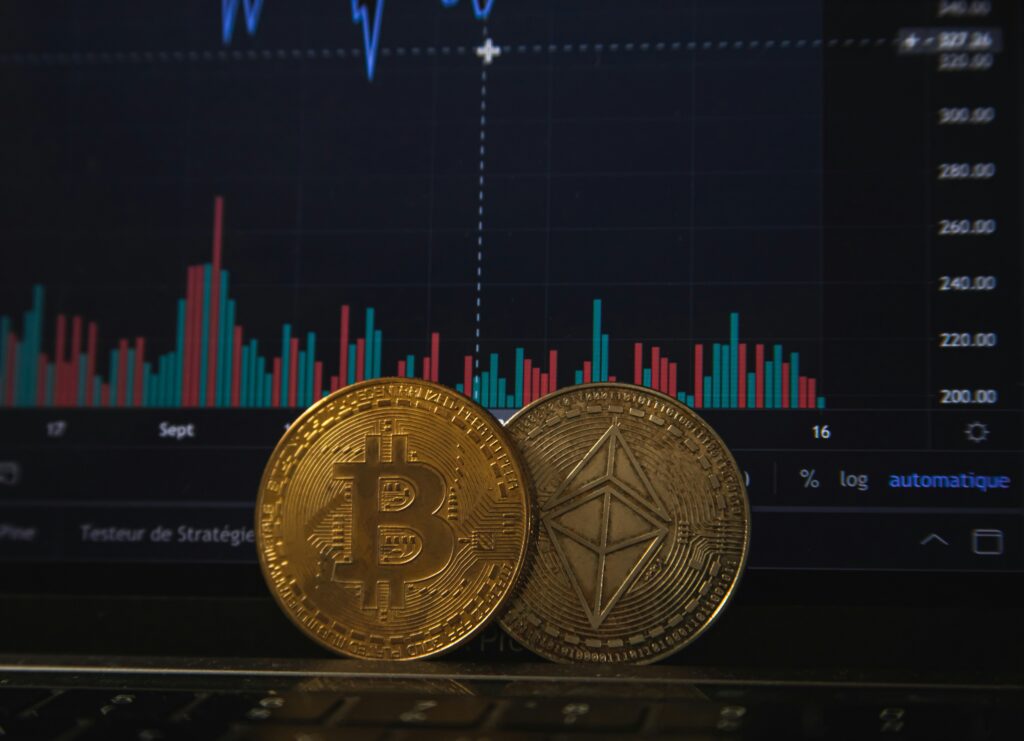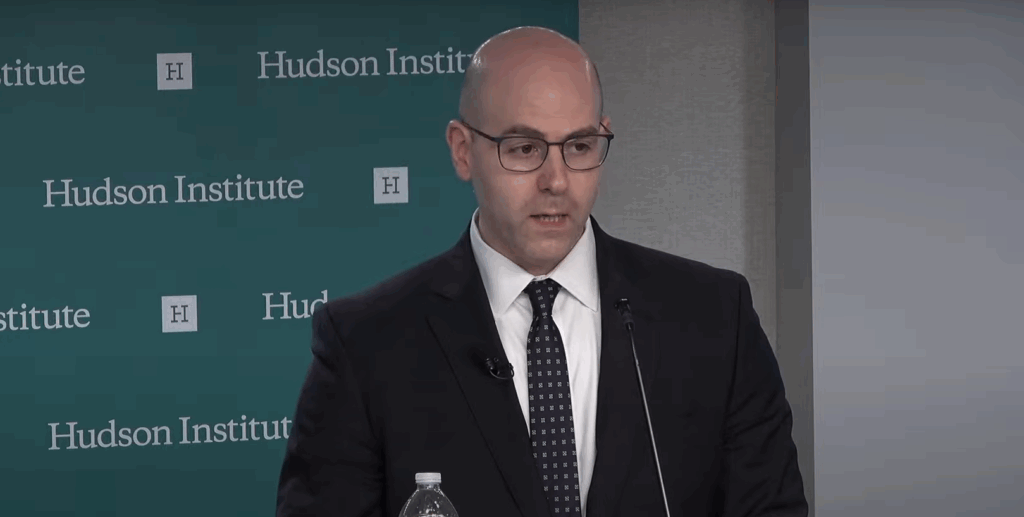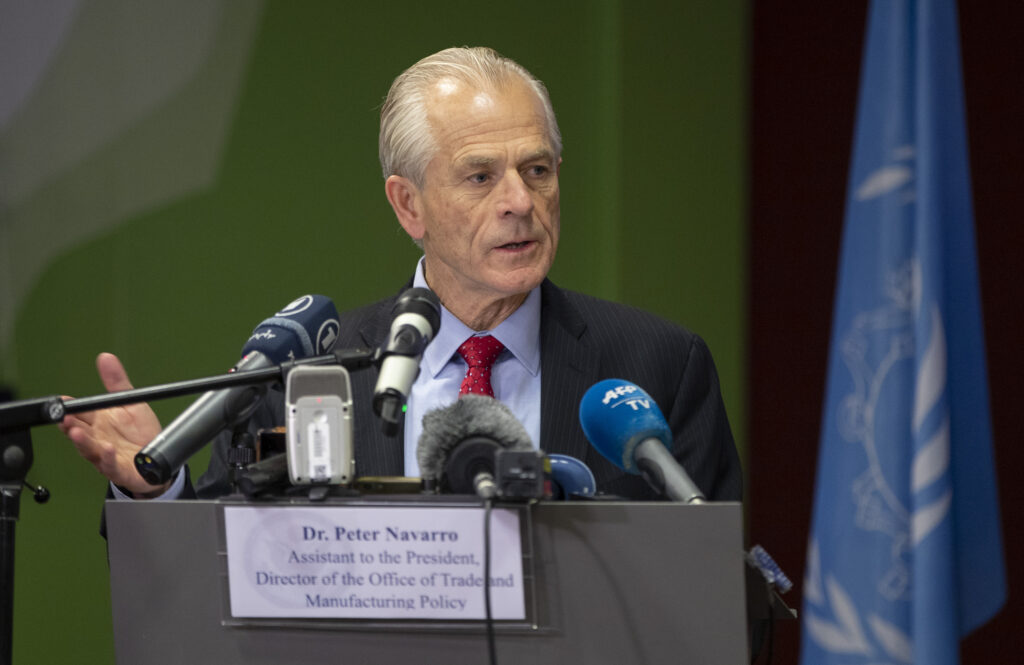
Research Associate & Manager, Trade 'n Technology Program
In the first 100 days of Donald Trump’s return to the White House, aside from tariffs, there are few economic shifts that have captured global attention like the administration’s dramatic embrace of cryptocurrency. What began as a campaign talking point has swiftly evolved into a sweeping institutional agenda: executive orders, personnel reshuffles, deregulatory frameworks, and a proposed Strategic Bitcoin Reserve all signal a government willing to redefine the architecture of financial governance in real time.
Yet beyond the slogans and symbolism lies a more deliberate logic. The Trump administration’s crypto strategy is not a repudiation of the U.S. dollar’s global role—but an effort to preserve and extend it through alternative financial channels. By outsourcing volatility, bypassing fiscal and monetary constraints, and harnessing speculative demand, the White House aims to project dollar influence without incurring its traditional liabilities.
This domestic experiment coincides with a geopolitical recalibration. As China advances its own centralized digital currency and challenges the norms of global trade, Washington is offering a radically different financial model—one built on decentralized rails, deregulated capital flows, and private-sector innovation. In this context, cryptocurrency is no longer a fringe asset. It is a strategic instrument—one that sits at the nexus of U.S. economic, political, and geopolitical recalibration.

In the public imagination, cryptocurrency has long been seen as a frontier of technological innovation—powered by blockchain protocols, decentralized verification, and large-scale computing infrastructure such as mining farms and cloud-based ledgers. But for Donald Trump, his embrace of crypto during the 2024 Presidential Election was never about its technological promise. It was about something else entirely: its symbolic power as a tool to rally anti-establishment voters and reassert his populist brand.
In a marked departure from his 2016 and 2020 campaigns, Trump’s 2024 presidential bid elevated digital assets from fringe innovation to a core tenet of the Republican Party platform. The shift was neither accidental nor rhetorical. It was, in effect, a deliberate rebranding of crypto—from volatile outsider technology to a political wedge issue uniquely suited to his anti-elite narrative.
Trump’s earlier hostility to the crypto industry is well-documented. During his first term, he dismissed Bitcoin as a “scam,” warning in a 2019 tweet that digital assets were “based on thin air” and could “facilitate unlawful behavior.” He also condemned Facebook’s Libra project as a threat to U.S. financial sovereignty. But by 2023, Trump began to shift course—launching a line of NFT-based trading cards and opening his 2024 campaign to crypto donations in Bitcoin and Ethereum. By then, crypto had transformed in Trump’s words—from a suspicious innovation into a symbol of resistance against institutional control over financial freedom. What has changed since was the rapid increase of crypto investments by the American people. Studies found that by 2025, 35 million U.S. adults are using crypto, and a large majority of them view crypto bringing positive change to their lives. Cryptocurrency, along other digital assets, have evolved from a financial fashion to somehow a conventional option for investment.
The 2024 Republican Party platform echoed this shift, vowing to “end Democrats’ unlawful and unAmerican crypto crackdown,” defend Americans’ right to mine Bitcoin, and oppose the creation of a Central Bank Digital Currency (CBDC). Crypto was reframed not as a financial asset class but as a matter of civil liberty—freedom from state surveillance, freedom to self-custody, and freedom to transact outside government control. Trump cast CBDCs as Orwellian tools of state overreach, warning that they would give Washington “total control over your money.” In his telling, crypto became the new frontier for personal autonomy.
This symbolic appeal of crypto also resonated with Trump’s broader political rhetoric. His appointments—ranging from anti-establishment voices like Elon Musk as head of the highly controversial Department of Government Efficiency, to the nomination of media figure Pete Hegseth as Secretary of Defense—signaled a broader theme of rejecting institutional norms in favor of political outsiders voices. In this sense, crypto was not an isolated issue but part of a larger anti-elite aesthetic—one that blurred the lines between civil liberty and political brand.
What emerged, then, was not a financial vision, but a populist one. Trump’s crypto pivot did not stem from a belief in the underlying technology; it was about narrative utility. In the fight for 2024, crypto was transformed from a speculative asset into a cultural signal—of rebellion, autonomy, and alignment with “real Americans” against the establishment.
In the first months of his second term, President Trump wasted no time in translating his campaign rhetoric on cryptocurrency into rapid institutional action. Within days of taking office on January 20, 2025, President Trump dismissed Securities and Exchange Commission (SEC) Chair Gary Gensler, whose tenure had been defined by an aggressive approach to classifying most crypto assets as unregistered securities. In Gensler’s place, Trump nominated Paul Atkins, a former SEC Commissioner known for his deregulatory views, especially in digital finance. The White House also nominated Brian Quintenz – head of policy at Andreessen Horowitz’s crypto arm and a longstanding vocal advocate for crypto-friendly oversight – to lead the Commodity Futures Trading Commission (CFTC). These personnel reshuffling signaled a deliberate shift from a disclosure-heavy, risk-averse regime to one favoring a permissive, commodity-style framework.
Further consolidating his crypto policy, President Trump appointed David Sacks, a tech investor and former PayPal executive, as the White House’s AI and Crypto Czar. Sacks was tasked with leading the President’s Working Group on Digital Asset Markets, aiming to provide regulatory clarity and foster innovation in the crypto industry. His appointment underscored the administration’s commitment to integrating crypto into the national economic strategy.
And they were more than symbolic appointments. By March, the Trump administration had effectively paused federal enforcement actions against major crypto exchanges—including Binance, Kraken, and Coinbase—pending jurisdictional review. Simultaneously, it threw its support behind several deregulatory legislative efforts in Congress. Chief among them was the H.R. 4763 – Financial Innovation and Technology for the 21st Century Act (FIT21 Act), passed by the House in May 2024 with limited bipartisan backing. The bill proposed a regulatory framework that would recognize most crypto tokens as “digital commodities,” placing them under CFTC oversight and effectively shielding them from many SEC disclosure and registration requirements. It also sought to formalize rules for decentralized finance (DeFi) protocols, exempting non-custodial platforms from traditional brokerage standards.
The administration’s moves reflected more than regulatory reform—they were part of a broader political logic. Crypto, long viewed as a vehicle for institutional distrust and monetary autonomy, became an ideal policy lever for stimulating economic energy without relying on congressional appropriations or interest rate cuts. In this context, digital assets were not just speculative tools, but alternative liquidity engines: mechanisms to channel capital, energize consumer activity, and attract investment—all while bypassing the usual macroeconomic levers constrained by political gridlock or inflationary risk.
This logic reached its most public expression on March 6, when Trump signed Executive Order 14097, instructing the Treasury to establish a Strategic Bitcoin Reserve. Modeled loosely on the U.S. Strategic Petroleum Reserve, the initiative cast digital assets as strategic sovereign hedges rather than fringe financial novelties. This reserve repurposes forfeited bitcoins from criminal and civil cases, currently valued at over $17 billion, to build a federal reserve of digital currency. The initiative positions the U.S. as a leader in digital assets, treating Bitcoin as a decentralized, capped-supply store of value akin to gold. While the Reserve remains modest in scale, its significance lies in future optionality: it reinforced the administration’s commitment to financial innovation and handed Washington a new tool for sovereign asset diversification.

The following day, President Trump hosted a summit at the White House with leaders from the crypto industry, including executives from Coinbase, Ripple, and Robinhood. During the meeting, Trump likened the reserve to a “digital Fort Knox for digital gold.”
Trump’s policy seriousness toward crypto also intersects with personal financial interest. Both Donald Trump and his family have direct commercial exposure to the crypto industry, including investments in digital asset ventures and associated tokens such as the $TRUMP coin and its affiliated holdings. Recent media reports have all detailed how the Trump family’s alleged holdings stand to benefit materially from rising crypto valuations and favorable regulatory treatment—raising concerns over potential conflicts of interest.
Those concerns came to a head during the Senate’s debate over the GENIUS Act in early May. Democratic lawmakers, citing ethical and constitutional questions, accused the White House of blurring the line between public policy and private gain. Senators pointed to the opaque ownership structures behind crypto-linked LLCs as grounds for delaying or diluting the legislation’s enforcement mechanisms, which eventually led to the failed passage of the GENIUS Act on May 8.
Still, not all outcomes of his institutionalization of cryptocurrency have favored the President. In a recent episode highlighting the unpredictability of Trump’s political world, top Republican lobbyist Brian Ballard—long seen as a trusted intermediary between the private sector and Trump’s inner circle—was sidelined after attempting to leverage the administration’s crypto push to secure preferential treatment for several DeFi firms. Ballard’s alleged ouster, reported by Politico, suggests that proximity to power in Trump’s Washington does not guarantee policy success, especially when it risks drawing negative media attention or violating Trump’s personal political calculus.
In the end, whatever the blend of ideology, personal interest, and political showmanship, Trump has remained remarkably committed to the institutionalization of a crypto-centric financial architecture—even in the face of foreseeable political backlash. And beyond his family’s investments or Beltway drama lies a deeper structural logic: for a debt-constrained, inflation-sensitive U.S. economy, crypto may serve as more than symbolism—it may be a central tool in Trump’s broader macroeconomic strategy.
Position | Appointee | Date | Relevant Action |
SEC Chair | Paul Atkins | Jan 21, 2025 | Replaced Gary Gensler; known for advocating industry-friendly regulation. Source |
CFTC Chair | Brian Quintenz | Feb 11, 2025 | Nominated to oversee CFTC. Source |
AI and Crypto Czar | David Sacks | Dec 6, 2024 | A new position created to advise on innovation policy and build coordination between AI and Crypto Policies. Source |
Order Title | Date | Summary |
Executive Order 14178 – Strengthening American Leadership in Digital Financial Technology | Jan 23, 2025 | Revoked previous digital asset policies; prohibited the establishment of a U.S. Central Bank Digital Currency (CBDC); established a group to propose a federal regulatory framework for digital assets within 180 days. Source |
Executive Order – Establishing a Strategic Bitcoin Reserve | Mar 6, 2025 | Directed the U.S. Treasury to establish a Strategic Bitcoin Reserve and a Digital Asset Stockpile, utilizing seized digital assets for strategic purposes. Source |
Bill / Resolution | Sponsor(s) | Status | Description |
H.R.4763 – Financial Innovation and Technology for the 21st Century Act (FIT21) | Rep. Glenn Thompson (R-PA) | Passed House, May 22, 2024 | Establishes a regulatory framework for digital assets, delineating responsibilities between the SEC and CFTC. Source |
H.R.2032 / S.954 – BITCOIN Act of 2025 | Rep. Nicholas Begich (R-AK) / Sen. Cynthia Lummis (R-WY) | Introduced Mar 11, 2025 | Proposes the acquisition of up to 1 million BTC over five years to establish a Strategic Bitcoin Reserve. House Version / Senate Version |
S.919 – GENIUS Act (Stablecoin Regulation) | Sen. Bill Hagerty (R-TN), Sen. Kirsten Gillibrand (D-NY) | Advanced to Senate Floor Mar 18, 2025 | Establishes licensing and regulatory requirements for stablecoin issuers, assigning oversight based on market capitalization. Source |
H.J.Res.25 – Providing for congressional disapproval under chapter 8 of title 5, United States Code, of the rule submitted by the Internal Revenue Service relating to “Gross Proceeds Reporting by Brokers That Regularly Provide Services Effectuating Digital Asset Sales”. | Rep. Carey, Mike [R-OH-15] | Became Law April 10, 2025 | Overturns a revised IRS rule that expanded the definition of a broker to include decentralized cryptocurrency exchanges. Source |
Donald Trump’s second term begins under the shadow of an American economy that, despite areas of resilience, remains riddled with structural constraints. At the heart of his administration’s crypto enthusiasm lies not just a rhetorical gambit but a strategic recalibration: cryptocurrency is being positioned as an unconventional instrument to address deep-rooted challenges—namely inflation, fiscal overextension, and a hollowed-out growth model—at a time when traditional policy levers are either exhausted or politically radioactive.
Despite inheriting a cooling Consumer Price Index, core price stickiness—especially in housing, services, and groceries—has kept real rates elevated. For a president styling himself as the “anti-inflation president,” Trump is politically constrained. Traditional rate cuts risk reigniting inflation; continued Fed hawkishness risks choking investment and growth.
This tension has personal and institutional roots.Having appointed Jerome Powell as Fed Chair in 2018, Trump soon turned against him, publicly accusing Powell of “failing the country” by refusing to cut interest rates more aggressively. By 2020, Trump called Powell an “enemy,” placing monetary policy squarely within his culture war narrative. Since the beginning of his second term, that narrative evolved further: where once Trump criticized the Fed for monetary conservatism, he now positions crypto as a bypass mechanism—a way to dilute the Fed’s influence without triggering the inflationary dangers of fiscal expansion. Powell, for his part, has continued to warn that crypto “is not money” and lacks the essential features of a monetary system. That, in Trump’s view, may be the point. In this framework, crypto becomes not just a speculative vehicle, but a monetary workaround—politically deniable, economically expandable.
Second is the debt concern. With public debt exceeding 120% of GDP and 2025’s debt ceiling standoff exposing partisan divides, the federal government faces mounting constraints on discretionary spending.Trump’s allies on Capitol Hill have rhetorically embraced deficit hawkishness as part of their agenda to denounce the Democratic “Big Government”, but remain reluctant to agree on necessary offsets or politically feasible budget cuts. Debates over entitlement cuts and the increasing defense further narrows the administration’s fiscal corridor when it comes to fixing the economy – too small for meaningful Keynesian stimulus, but too politically salient to just let be.
In this constrained environment, rather than confront budget battles repeatedly, crypto offers Trump what Congress cannot: a parallel liquidity engine capable of stimulating economic activity without new appropriations. The Strategic Bitcoin Reserve—though modest in size—was an attempt to generate market movement without adding to the Treasury’s balance sheet. It also provides a speculative “sovereign hedge” narrative, which helps draw capital into U.S. financial markets without having to defend conventional monetary expansion.
More notably, crypto enjoys limited but real bipartisan support: the creation of the Congressional Crypto Caucus in March and bills like the GENIUS Act demonstrate that, at least on innovation and stablecoin infrastructure, there is room for legislative cooperation. Still, this consensus remains fragile, as some Democrats continue to raise concerns over market volatility, consumer protection, and alleged public corruption.
This indeed represents a departure from traditional balance sheet logic—but it reflects the politics of scarcity that now define Washington. The only matter is, how much support and capital can the White House rally? Only time and the market will tell.
The third and perhaps most daunting constraint is structural. Despite strong tech sector performance, much of the post-2020s recovery remains reliant on asset inflation and consumer credit. Traditional industrial investment has stalled, and real wage growth has decoupled from productivity gains. The “old economy” lacks dynamism, but the “new economy” is capital-intensive and top-heavy. Crypto enters here as a synthetic growth layer: a way to manufacture investment activity, capital inflow, and innovation rhetoric in sectors that require little government planning and generate media-friendly volatility.
It is this structural logic that undergirds much of Trump’s second-term economic agenda. As articulated by Stephen Miran, the White House’s Chairman of Council of Economic Advisers, the future of U.S. economic competitiveness lies in outsourcing volatility, attracting capital, and reengineering globalization around new financial rails. In his framework, crypto serves as a pressure valve: relieving the dollar of some of its hegemonic burdens by providing dollar-linked alternatives that operate outside of sovereign risk.
This outlook explains why crypto deregulation is unfolding alongside more traditional policy levers. President Trump’s 2025 budget framework, while ostensibly focused on deficit reduction, leaves ample room for private-sector-led innovation incentives, especially in blockchain and digital assets. Simultaneously, the reintroduction of targeted tariffs on Chinese imports reflects an effort to rewire capital flows toward domestic substitutes, while crypto provides an abstracted asset layer to absorb redirected liquidity.
Far from undermining the dollar, then, the embrace of digital assets may serve to reinforce it—by extending the dollar’s functional reach into spaces where formal fiscal or monetary levers cannot easily operate. Whether this experiment can succeed without introducing new forms of systemic risk remains uncertain. But its logic is rooted not in speculative fervor alone, but in a fundamental recognition: the post-pandemic U.S. economy needs new channels of demand creation, and Washington’s traditional policy toolkit—tired, over-politicized, and debt-constrained—is no longer sufficient.
Looking beyond the U.S. domestic issues, at the core of Washington’s emerging digital asset strategy lies a strategic recognition: the competition for global financial leadership in the 21st century will unfold not only through interest rates or trade routes, but through the architecture of digital finance itself. While much attention has focused on the domestic motivations behind Trump’s crypto pivot, its geopolitical dimension is equally pivotal—particularly in the context of an intensifying rivalry with China that Trump himself helped institutionalize during his first term.
Over the past five years, China has accelerated its development and deployment of the digital yuan (e-CNY), piloted by the People’s Bank of China as both a tool for domestic modernization and an instrument for cross-border transactions. Beijing’s aim is clear: to extend financial influence through the Belt and Road Initiative and platforms like BRICS, while positioning its central bank digital currency (CBDC) as a credible alternative to the U.S. dollar in global settlements. The IMF have flagged e-CNY’s progress as a potential disruptor to dollar primacy—raising policy discussions and concerns in Washington that it could erode the dollar’s centrality in global settlements.
In contrast, the Trump administration is championing an alternative model that could not be more ideologically and operationally different. Rather than a state-issued and state-controlled currency, the U.S. approach in 2025 favors dollar-denominated stablecoins, decentralized networks, and a regulatory light-touch. The strategy is not accidental. As articulated by Stephen Miran, maintaining dollar hegemony in a multipolar world may require relinquishing some of its traditional responsibilities—namely, providing cheap liquidity and absorbing external financial shocks. Instead, the U.S. can extend dollar usage through privatized, crypto-linked platforms that circulate globally without the full burden of monetary and fiscal accommodation.

In this light, Trump’s crypto vision is not a retreat from dollar dominance, but its recalibration. By expanding the dollar’s functional footprint into decentralized crypto markets, the administration seeks to extend dollar usage without amplifying domestic monetary burdens. In effect, it outsources risk—allowing global actors to transact, speculate, and store value in dollar-linked instruments without directly implicating U.S. fiscal or monetary policy. This helps preserve the dollar’s global reach while shielding it from the structural consequences of that reach.
Beijing’s model, meanwhile, suffers from the very traits that make it appealing to regulators: centralized issuance, low volatility, and high surveillance. While these attributes are well-suited for domestic governance and state-to-state settlements, they lack the speculative upside and market freedom that crypto-driven ecosystems promise. In that gap lies Washington’s strategic bet—that capital will gravitate toward freedom, even if it comes wrapped in volatility.
Ultimately, the contest is not simply over whose CBDC launches first or works best. It is over which system becomes the de facto operating layer for global finance—and whether that layer is defined by control and certainty, or volatility and liquidity. Neither China nor the U.S. has secured victory, but Trump’s embrace of crypto signals a clear intent: to outcompete Beijing in digital finance not by imitation, but by reinvention.
The Trump administration’s digital asset strategy does not exist in a vacuum. Rather, it forms part of a broader effort to redraw the global economic map—where tariff escalation, capital control asymmetries, and token-based financial instruments serve a common objective: to reassert U.S. economic autonomy while engineering a selective decoupling from China’s industrial-financial nexus.
The ongoing tariff war with China is often interpreted as a trade policy maneuver aimed at protecting domestic manufacturing. But in the context of the administration’s broader financial policy, tariffs also function as a macro-prudential tool—a lever to redirect capital flows, contain supply-chain dependencies, and create new zones of domestic reinvestment. By basically cutting off trade ties with China through tariffs above 100%, the Trump administration is pushing for a de facto decoupling with China, especially in the capital market, where global capital is extremely sensitive to market turbulence.
This decoupling strategy is not incidental; it is consistently driven by key figures within Trump’s economic team. Peter Navarro, serving as senior counselor for trade and manufacturing, has long advocated for a complete economic separation from China. He has described China as an existential threat to the U.S. economy and has been instrumental in shaping the administration’s hardline trade policies. Navarro’s stance is that every dollar spent on Chinese goods supports an authoritarian regime, and he has pushed for high tariffs and the repatriation of global supply chains.

Similarly, Stephen Miran, has articulated a vision of economic decoupling as a means to restructure the global trading system. In his policy blueprint, Miran argues for the use of unilateral tariffs to pressure trade partners and reduce reliance on China-centric supply chains. He emphasizes the need for the U.S. to shed the burdens associated with maintaining the dollar’s reserve currency status, advocating for alternative financial instruments to attract global capital without the traditional liabilities. Miran, while not as ideological as Navarro, favors using tariffs to force for detente and concession – an idea China would never agree on – forcing the de facto decoupling to deepen as trade impasse continues.
Where traditional capital controls often provoke diplomatic backlash or violate international trade norms, tokenization offers a workaround: by creating new, opaque asset classes, it allows governments to filter, route, and attract capital without engaging in overt restriction or subsidy. In this way, crypto becomes not merely a domestic deregulatory experiment, but a functional layer in capital competition—capable of insulating U.S. markets from Chinese financial entanglement while absorbing excess global liquidity.
Importantly, the capital decoupling is not bilateral—it is asymmetric. China’s existential system continues to restrict outbound investment and limit cross-border financial exposure through quota-based programs like Qualified Domestic Institutional Investor (QDII) . The United States, by contrast, aims to remain an open magnet for mobile capital, but under new terms: offering high-yield, high-risk, digitally securitized entry points that exist beyond the reach of traditional financial intermediation such as the treasury bonds. These include crypto ETFs, tokenized real estate trusts, and even speculative synthetic instruments linked to geopolitical events or commodity flows.
The effect is strategic. As direct investment flows between the two economies slow, the U.S. seeks to pull global capital away from Chinese-linked markets, not by prohibiting them, but by outcompeting them—offering volatility, scale, and freedom. The endgame is a financial architecture in which U.S.-centric digital assets, rather than yuan-based state assets, dominate the speculative layer of global capital allocation. In doing so, it is the administration’s hope to reduce exposure to Chinese systemic risk, while reinforcing the dollar’s gravitational pull.
For all the ideological fervor surrounding digital currencies, global capital remains remarkably pragmatic. In theory, China’s rise as a manufacturing superpower—coupled with its experimentation in digital yuan—should have made it an increasingly attractive destination for international investment. In practice, however, global liquidity will continue to flow toward the United States, even as the American economy appears fiscally overstretched and its financial assets arguably overvalued. This paradox is not the result of ideological preference, but rather the product of a deep structural asymmetry between the two systems.
China’s financial system—by design—remains industry-oriented and policy-controlled. It serves the goal of long-term national development, not short-term capital gratification. Its bond markets are dominated by state-linked issuers. Its stock exchanges are tightly regulated. Its outbound capital channels are gated. Even its most promising sectors, like green energy or semiconductors, are steered by national strategy rather than speculative demand. For global investors, this makes China a market of “slow money”—stable, scalable, but unsuited for high-velocity returns.
By contrast, under Trump’s watch, the U.S. capital system has evolved to specialize in absorbing global surplus liquidity. Through asset inflation, financial innovation, and regulatory arbitrage, it offers what no other economy can: the ability to generate alpha in a low-growth world. Crypto fits perfectly into this system. It offers volatility, novelty, and the illusion of productivity—all the conditions global capital craves when interest rates are high, but political constraints preclude fiscal expansion. In effect, crypto extends America’s comparative advantage in risk-based capital absorption, channeling speculative demand into dollar-linked, U.S.-hosted digital instruments.
This asymmetry is not an indictment of either system. China’s financial restraint is a product of its institutional logic and development priorities. But as long as Beijing remains wary of speculative bubbles, and as long as its currency is not freely convertible, the world’s surplus capital will gravitate toward the only market willing to package volatility as opportunity—Wall Street, and now, Washington’s emerging crypto-industrial complex.
From the Trump administration’s perspective, this is not a problem—it is a design feature. In fact, crypto offers a rare alignment of interests: it allows Washington to preserve the dollar’s centrality, attract global capital without increasing sovereign debt, and do so through private-sector innovation that requires minimal state expenditure. In the short term, this logic is compelling. International liquidity continues to favor the United States—not because it offers stability, but because it promises immediacy.
Indeed, Trump’s broader economic strategy—from his tariff escalations to the crypto buildout—is calibrated to deliver short-term impact, ideally before the midterm election of 2026. Whether decoupling from Chinese supply chains or soaking up crypto capital, the goal is immediate effect, not institutional longevity. In this way, Trump’s short-termism is not just ideological—it is structural. With only four years in office, and surrounded by a fractious Congress and an oppositional bureaucracy, Trump governs with velocity and has little time for economic patience.
Yet therein lies the contradiction. The very volatility that attracts capital today may undermine the appeal of the U.S. market in the long term. As the novelty of crypto wears thin and investors begin to seek predictable, policy-stable growth environments, China’s model—however illiberal in Western terms—may grow more attractive. Its emphasis on industrial planning, capital discipline, and systemic continuity offers a radically different vision of capital governance: one less exciting, but more durable.
Whether the financial “New Order” Trump is engineering can outlast its own political half-life remains to be seen. For now, crypto capital still flows to America. But “for now” may be the operative phrase.
President Trump’s second-term crypto agenda is not merely a regulatory curiosity—it is a window into how the United States is reimagining the projection of financial power under structural constraint. By aligning itself with dollar-linked digital assets, the Trump administration is attempting to modernize dollar dominance while shedding the burdens of fiscal expansion, monetary orthodoxy, and institutional deliberation. Crypto, in this context, is not a rebellion against the U.S. financial order—it is its workaround.
This crypto-enabled architecture offers Washington short-term advantages: global capital inflows, policy deniability, and strategic flexibility at a time when traditional tools are constrained by inflation, debt, and political gridlock. But it is a high-volatility model built on speculative liquidity and compressed timelines. Whether such a system can deliver more than transitory gains remains uncertain.
One critical inflection point lies ahead: the expected departure of Federal Reserve Chair Jerome Powell in 2026. With an opportunity to reshape the monetary establishment from the inside, the Trump administration may face a pivotal choice—double down on crypto as a structural alternative, or return to more conventional levers once institutional control is secured. Much will hinge on how Trump navigates the 2026 midterms, which his allies have framed as the true mandate for his economic legacy.
Crypto, then, may not be the endgame. It is a bridge—designed to absorb time, risk, and contradiction. Whether that bridge leads to a durable new financial order or collapses under the weight of its own improvisation remains to be seen. But in the Trump era, one thing is clear: volatility is not a cost. It is the model.

The Institute for China-America Studies is an independent nonprofit, nonpartisan research organization dedicated to strengthening the understanding of U.S.-China relations through expert analysis and practical policy solutions.
1919 M St. NW Suite 310,
Washington, DC 20036
icas@chinaus-icas.org
(202) 968-0595
© 2025 INSTITUTE FOR CHINA-AMERICA STUDIES. ALL RIGHTS RESERVED.
The U.S. Auto Industry Has Not Lost Yet—But It Must Compete Smarter